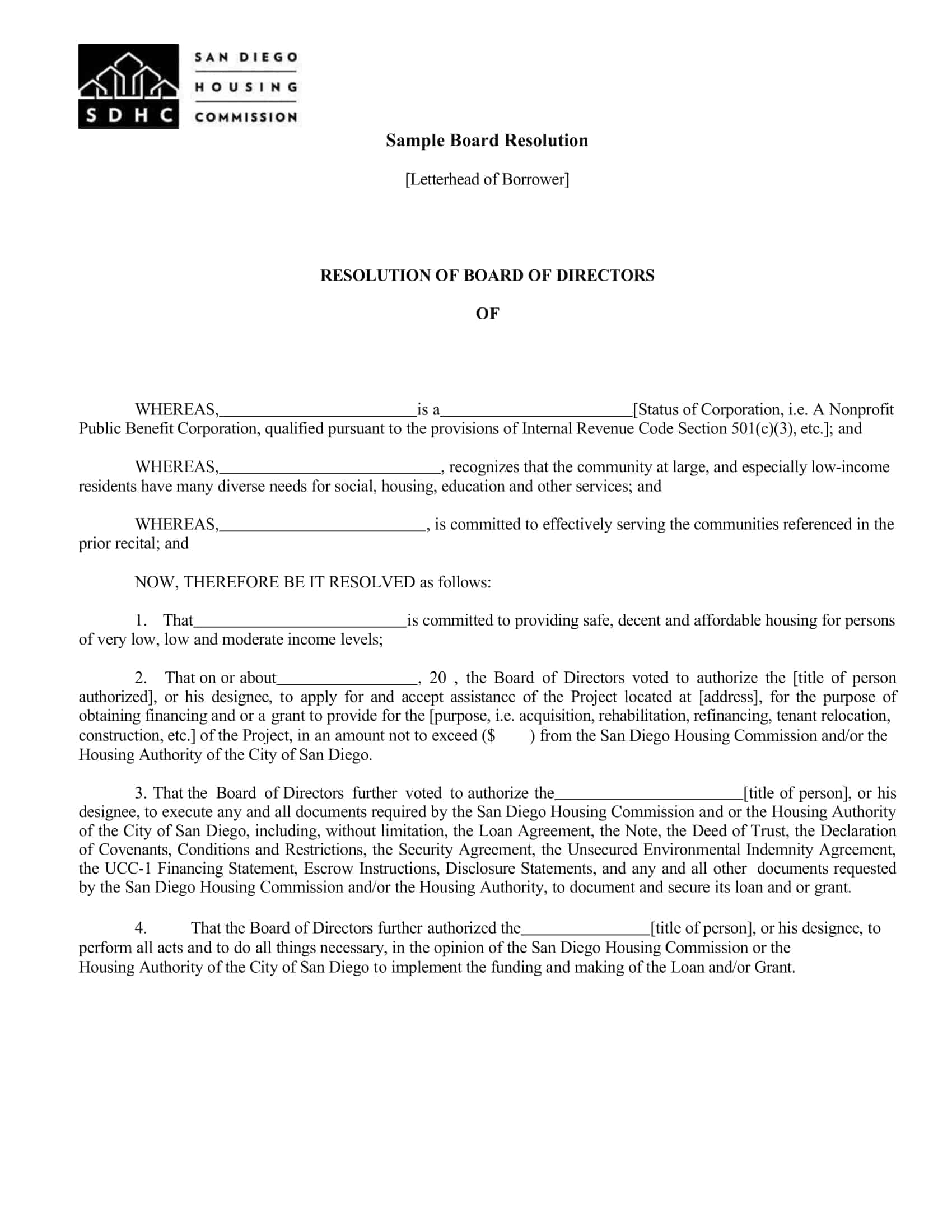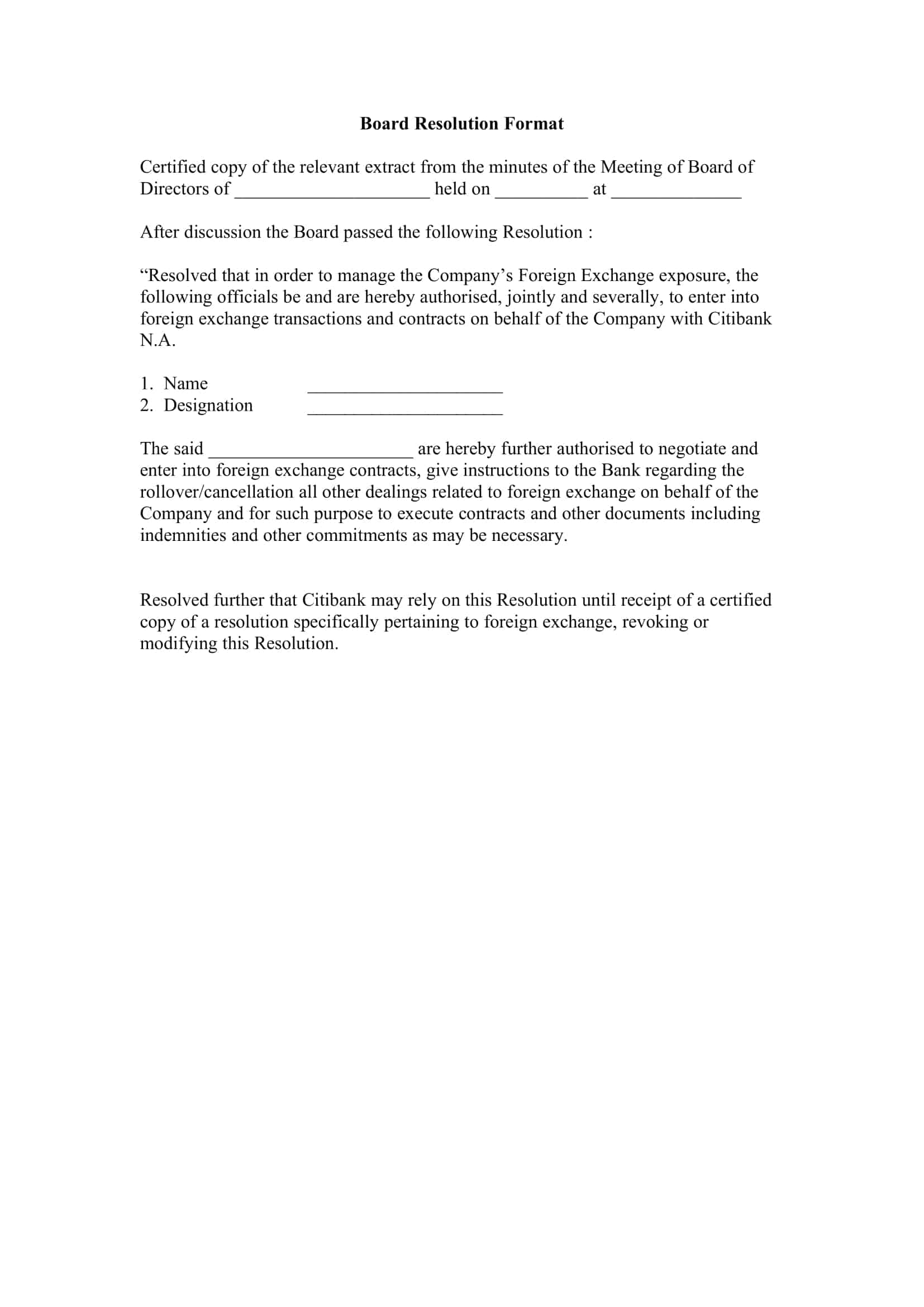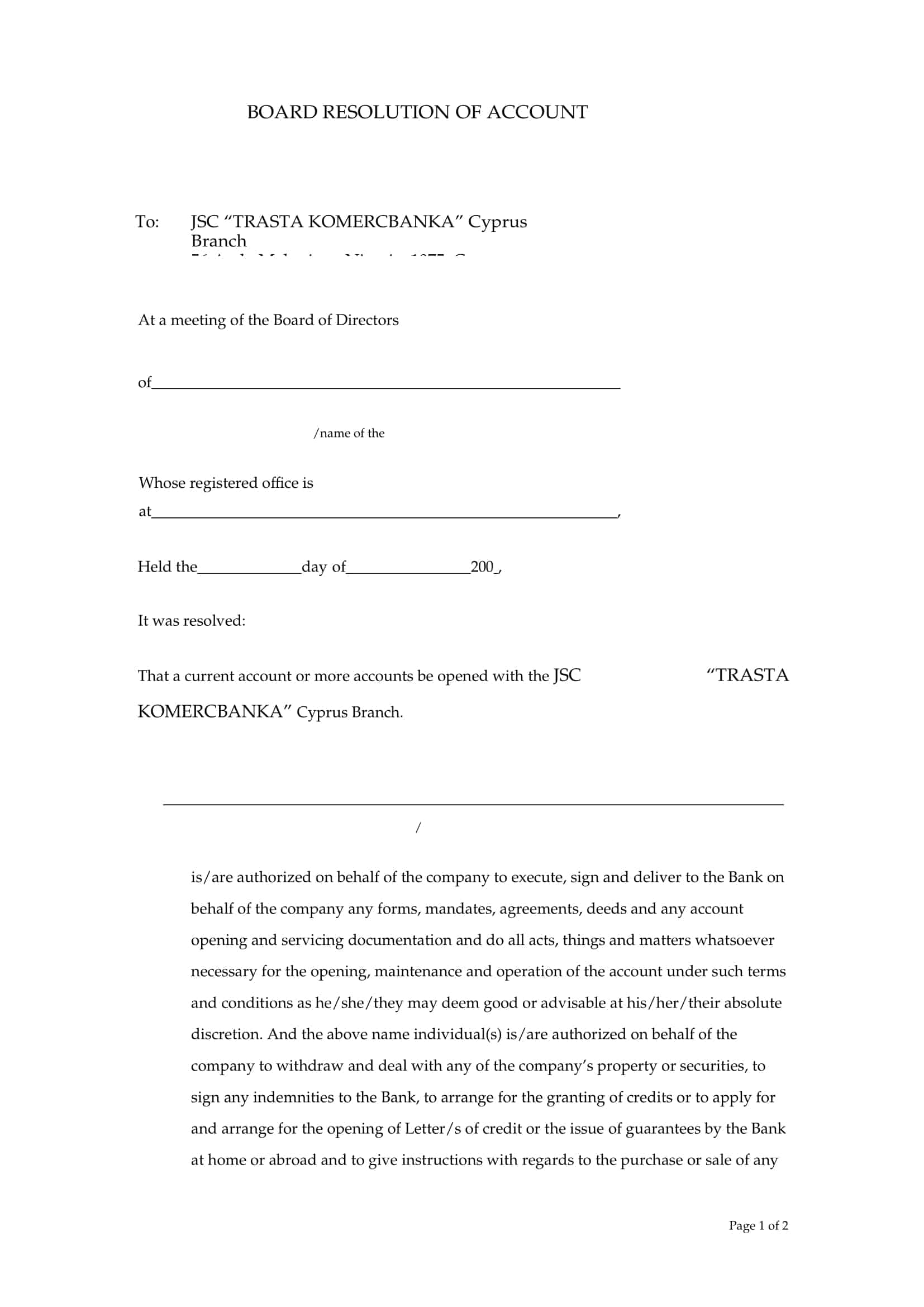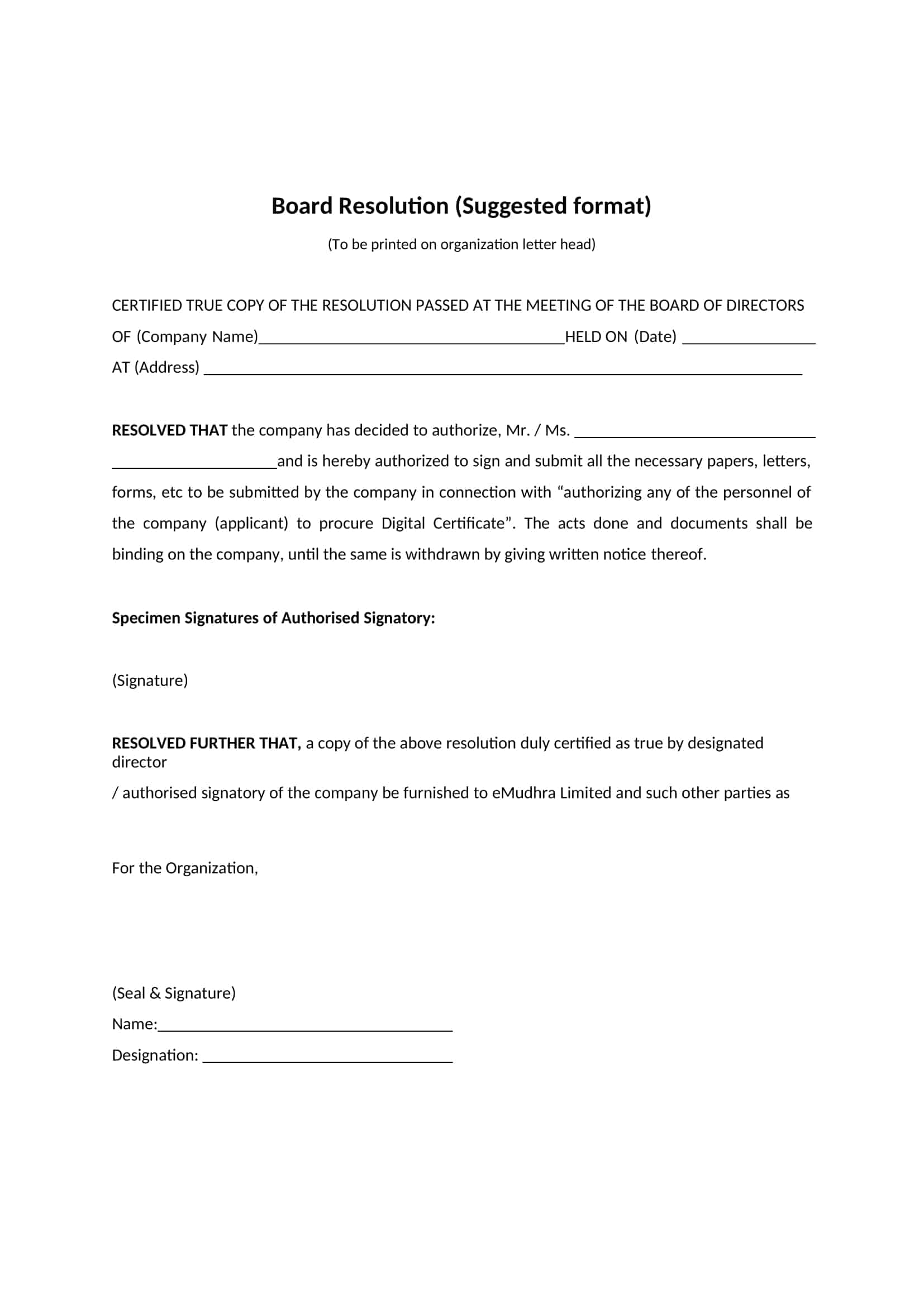Board resolutions are formal documents that outline important decisions made by the board of directors of a corporation. These resolutions are typically adopted into the company’s corporate record and outline the actions that the board has authorized or required in relation to the company’s operations.
Preparing a board resolution can seem intimidating due to the formal language and legal requirements involved, but with the right tools and guidance, it can be a straightforward process. In this article, we will take a closer look at board resolution templates and provide tips for creating and using them effectively.
Table of Contents
Board Resolution Templates
Board meeting agenda templates are pre-designed documents that provide a structured format for organizing and conducting effective board meetings. These templates serve as a blueprint for creating agendas that ensure important topics are discussed, decisions are made, and actions are taken during board meetings.
Board meeting agenda templates typically include sections for the meeting date, time, and location, as well as a list of items to be discussed and addressed during the meeting. They may also include sections for reviewing previous meeting minutes, presenting reports, discussing specific topics, and allocating time for open discussions or presentations.
Using a board meeting agenda template helps streamline the meeting planning process and ensures that board members and attendees have a clear understanding of the meeting’s purpose and objectives. It allows for the prioritization of important agenda items and helps maintain focus and efficiency during the meeting.
What Is a Board Resolution Template?

A board resolution template is a pre-formatted document that outlines the structure and content of a board resolution. It typically includes placeholders for the necessary information, such as the date, the name of the company, the names of the directors present, and the details of the resolution being adopted.
The template can be used as a starting point for creating a new board resolution and can help to ensure that the resolution is properly formatted and includes all of the necessary information. Some templates may also include sample language or guidance on how to draft specific types of resolutions, such as resolutions related to the appointment of directors or the authorization of a particular action.
When to use a board resolution template?
A board resolution template can be used any time that the board of directors of a corporation needs to pass a resolution. This may include instances such as:
Appointing new directors: This refers to the process of selecting and appointing new members to the board of directors. This may be necessary if there are vacancies on the board or if the company is expanding and needs to add additional directors.
Electing officers of the company: This refers to the process of selecting and appointing the officers of the company, such as the president, vice president, secretary, and treasurer. These individuals are responsible for carrying out the day-to-day operations of the company and implementing the decisions of the board.
Authorizing the issuance of stock: This refers to the process of issuing new shares of stock in the company. This may be done to raise capital, to grant stock options to employees, or for other purposes.
Approving the sale or purchase of assets: This refers to the process of approving the sale or purchase of significant assets, such as real estate, equipment, or intellectual property.
Establishing committees: This refers to the process of setting up committees within the company, such as a finance committee or a marketing committee. These committees may be responsible for making recommendations or decisions on specific areas of the company’s operations.
Approving the budget or financial plan: This refers to the process of reviewing and approving the company’s budget or financial plan for the coming year.
Setting policies or procedures: This refers to the process of establishing policies or procedures that govern the operation of the company.
Taking any other action that requires the board’s approval: This refers to any other action that the board of directors needs to consider and approve. This could include things like changing the company’s legal structure, entering into a partnership or joint venture, or making other major decisions that have significant implications for the company.
Using a board resolution template can help to ensure that the resolution is properly formatted and includes all of the necessary information, which can help to make the adoption process more efficient and smooth. It can also help to ensure that the resolution is legally valid and properly recorded in the company’s corporate records.
Why do you need to create a board resolution template?
There are several reasons why you might need to create a board resolution template:
- To ensure that the resolution is properly formatted: A board resolution template can help to ensure that the resolution is properly formatted and includes all of the necessary information, such as the date, the names of the directors present, and the details of the resolution being adopted. This can help to make the adoption process more efficient and smooth, and can also help to ensure that the resolution is legally valid and properly recorded in the company’s corporate records.
- To save time: Using a board resolution template can save time by providing a pre-formatted document that can be used as a starting point for creating a new resolution. This can be especially helpful if you need to create multiple resolutions or if you are not familiar with the process of drafting a resolution.
- To provide guidance: Some board resolution templates may include sample language or guidance on how to draft specific types of resolutions. This can be helpful if you are unsure about how to structure or word a particular resolution.
- To establish a consistent format: By using the same template for all of your board resolutions, you can establish a consistent format that is easy to follow and understand. This can help to make the resolutions more organized and professional, and can also make it easier to locate specific resolutions in the company’s corporate records.
- To make it easier to update or modify resolutions: If you need to update or modify a resolution that has already been adopted, using a template can make it easier to make the necessary changes. You can simply make the necessary edits to the template and then pass the updated resolution as needed.
- To ensure compliance with legal requirements: Depending on your jurisdiction, there may be specific legal requirements for the content and format of board resolutions. Using a template can help to ensure that you are complying with these requirements and that your resolutions are legally valid.
In general, creating a board resolution template can be a useful tool for streamlining the process of drafting and adopting resolutions and for ensuring that the resolutions are properly formatted and legally valid.
Who prepares a board resolution template?
Typically, the board of directors of a corporation is responsible for creating and adopting board resolutions. This includes the process of creating a board resolution template. However, it is not uncommon for companies to seek the assistance of legal counsel or other advisors when preparing board resolutions, including templates. These advisors can provide guidance on the legal requirements for the content and format of resolutions and can help to ensure that the templates are accurate and compliant with the relevant laws.
In some cases, the board may delegate the responsibility for creating the template to a particular individual or committee within the company, such as the corporate secretary or the legal department. This can be helpful if the board does not have the time or expertise to create the template themselves.
Overall, the board of directors is responsible for creating and adopting board resolutions, including board resolution templates, but they may seek the assistance of legal or other advisors as needed.
When to hold board resolutions?
Board resolutions are typically adopted at a meeting of the board of directors. This could be a regularly scheduled meeting or a special meeting called specifically to consider the resolution. The timing of the meeting will depend on the needs and circumstances of the company and the specific resolution being considered.
In some cases, board resolutions may be adopted by unanimous consent, which means that the directors can approve the resolution without the need for a formal meeting. This can be done if all of the directors agree to the resolution and are willing to sign a written consent form.
Overall, board resolutions are typically adopted at a meeting of the board of directors, but they can also be adopted by unanimous consent if all of the directors agree to the resolution. The timing of the resolution will depend on the needs and circumstances of the company and the specific resolution being considered.
Types of board resolutions
Board resolutions are formal documents that outline important decisions made by the board of directors of a corporation. These resolutions can take many different forms, depending on the nature of the decision being made and the needs of the company. In this article, we will explore the various types of board resolutions and provide examples of how they can be used effectively.
And here are some types of board resolutions:
Ordinary resolutions: These are resolutions that relate to the ordinary business of the company and do not require the approval of the shareholders. They may be used to appoint directors, elect officers, set policies, and take other actions that are necessary for the day-to-day operation of the company.
Special resolutions: These are resolutions that relate to more significant or unusual matters that require the approval of the shareholders. They may be used to amend the company’s articles of incorporation, change the company’s legal structure, or take other major actions that have significant implications for the company.
Written resolutions: These are resolutions that are adopted in writing rather than at a formal meeting of the board. They may be used when it is not practical to hold a meeting, or when all of the directors agree to the resolution and are willing to sign a written consent form.
Unanimous resolutions: These are resolutions that are adopted by unanimous consent, which means that all of the directors agree to the resolution and are willing to sign a written consent form.
By understanding the different types of board resolutions and using them appropriately, you can ensure that important decisions are properly documented and adopted in a legally valid manner.
Tips for Writing a Board Resolution
Use a clear and concise title: The title of the resolution should clearly and concisely summarize the main purpose of the resolution. This will help the directors to understand the resolution and take action accordingly.
Use formal language: Board resolutions are formal documents and should be written in a formal and professional tone. Avoid using slang or colloquial language and be sure to use proper grammar and punctuation.
Be specific: Clearly state the purpose of the resolution and provide any necessary details, such as the names of the directors present, the date, and the specific actions being authorized or required.
Use bullet points or numbered lists: If you have a lot of information to include in the resolution, consider using bullet points or numbered lists to make it easier for the directors to scan and understand.
Use active voice: Use active voice when writing the resolution to make it more direct and action-oriented. For example, “The board approves the budget for the coming year” is written in active voice, while “The budget for the coming year is approved by the board” is written in passive voice.
By following these tips, you can write a board resolution that is clear, concise, and professional, and that effectively communicates the actions being taken by the board.
Conclusion
In conclusion, board resolutions are important tools for documenting and implementing the decisions of the board of directors of a corporation. By understanding the different types of resolutions and following best practices for writing them, you can ensure that your resolutions are clear, concise, and legally valid.
Whether you are adopting an ordinary resolution, a special resolution, a written resolution, or a unanimous resolution, it is important to use formal language, be specific, and use active voice to effectively communicate the actions being taken by the board. By following these guidelines, you can create board resolutions that are professional, effective, and legally sound.
FAQs
How do you write a board resolution?
To write a board resolution, first identify the issue or decision that needs to be documented. The resolution should clearly state the action being approved and authorize the proper officers to execute associated documents. Include relevant facts and resolutions that led to the decision. Maintain a formal legal tone and proper formatting. Typically resolutions have numbered clauses starting with “RESOLVED THAT…” Indicate the approval date and attach as an exhibit to the board meeting minutes.
What is a board resolution example?
A board resolution example could read:
RESOLVED THAT the Board of Directors hereby authorizes the purchase of 3,000 additional shares of Acme Inc. stock at the price of $50 per share. This purchase is made based on the recommendation of the Investment Committee in accordance with the company’s investment guidelines. The Chief Financial Officer is authorized to execute the stock purchase agreement on behalf of the company.
What is the difference between a board resolution and a written resolution?
Board resolutions are passed at board meetings with multiple directors present. Written resolutions are passed without a meeting and are signed by all directors to indicate approval. Both formats result in legally binding decisions.
What is a normal board resolution?
A normal board resolution covers matters like approving budgets/expenses, authorizing contracts or signers, opening bank accounts, directing management on business deals, and appointing officers. Routine board resolutions don’t amend bylaws or have major corporate impacts. They simply document standard board decisions.



















































![Free Printable Roommate Agreement Templates [Word, PDF] 1 Roommate Agreement](https://www.typecalendar.com/wp-content/uploads/2023/06/Roommate-Agreement-150x150.jpg)
![Free Printable Credit Card Authorization Form Templates [PDF, Word, Excel] 2 Credit Card Authorization Form](https://www.typecalendar.com/wp-content/uploads/2023/06/Credit-Card-Authorization-Form-150x150.jpg)
![Free Printable Stock Ledger Templates [Excel,PDF, Word] 3 Stock Ledger](https://www.typecalendar.com/wp-content/uploads/2023/08/Stock-Ledger-150x150.jpg)
